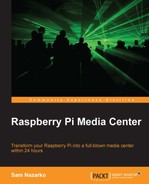Low-cost and high-performing, with a massively diverse range of uses and applications, the Raspberry Pi is set to revolutionize the way we think about computing and programming. Using it as a media center allows everyone to have a low-cost device that is always on and attached to their TV.
Imagine controlling your TV with your smartphone, dynamically streaming content that you have on various devices in your home, as and when you want. Raspberry Pi Media Center will show you how to configure the complete experience using readily available and accessible tools, so that you too will soon be enjoying your media from the comfort of your own sofa.
With this practical guide, you'll discover how you can transform your Raspberry Pi into a powerful media center. Using Raspbmc (based on the XBMC distribution), you'll be shown how you can deploy and configure your own media center, including the coverage of all the essentials, from controlling your device with a TV remote or smartphone to the creation and customization of your very own media library (including the conversion of any existing collection). You'll even be able to stream multimedia from your devices or directly from the Internet!
Chapter 1, Getting Started, explores why the Raspberry Pi is a good hardware choice for a media center, lists the equipment we will need to install media center, and gives a brief introduction to Raspbmc and how to install it.
Chapter 2, Using Raspbmc, explains how to navigate and control Raspbmc as well as configure important settings and install add-ons.
Chapter 3, Managing Content, explains how to add existing content for playback, the content sources and types Raspbmc supports, and how to add these sources and manage them.
Chapter 4, Streaming From a Computer, explains what's needed to stream media from your computer, the advantages and disadvantages of streaming, and how to set up streaming from Windows, Linux, and Mac OS X computers.
Chapter 5, Setting up the Library Mode, explains how we can store information, such as episode descriptions of our content, in a database, sharing this across multiple machines, and getting Raspbmc to recognize this database.
Chapter 6, Using PVR with Raspbmc, explains what we can do with PVR, gives us a look at the different types of PVR setups, and explains how to configure Raspbmc to use PVR.
Chapter 7, Converting Media, explains why converting media is necessary, gives us a look at codecs, and explains how to convert media with freely available software so it can be played in Raspbmc.
Appendix A, Useful Raspbmc Commands, provides useful commands that can be executed via the command line with an attached keyboard or via an SSH connection.
Appendix B, Useful MySQL Commands, provides a short summary of MySQL commands that can be used at the command line on the system that is hosting the MySQL database.
Appendix C, Supported Peripherals, provides a summary of supported peripherals in Raspbmc.
